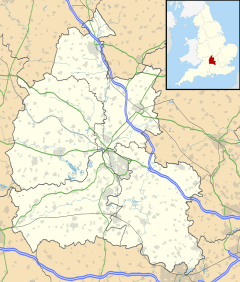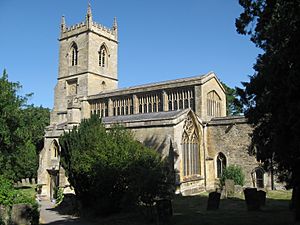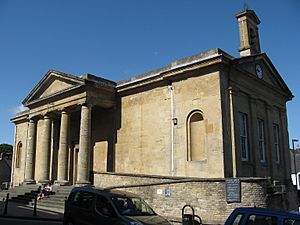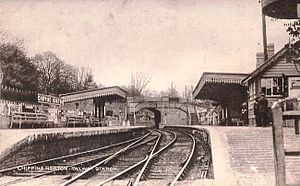Chipping Norton facts for kids
Quick facts for kids Chipping Norton |
|
|---|---|
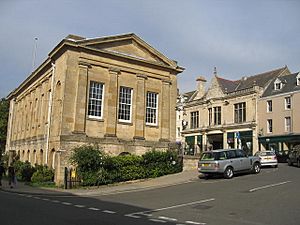 Chipping Norton Town Hall, built 1842 |
|
| Population | 5,719 (2011 Census) |
| OS grid reference | SP309269 |
| • London | 74+1⁄2 miles (120 km) |
| Civil parish |
|
| District |
|
| Shire county | |
| Region | |
| Country | England |
| Sovereign state | United Kingdom |
| Post town | Chipping Norton |
| Postcode district | OX7 |
| Dialling code | 01608 |
| Police | Thames Valley |
| Fire | Oxfordshire |
| Ambulance | South Central |
| EU Parliament | South East England |
| UK Parliament |
|
| Website | Chipping Norton Town Council |
Chipping Norton is a lively market town located in the beautiful Cotswold Hills in Oxfordshire, England. It's about 12 miles south-west of Banbury and 18 miles north-west of Oxford. In 2011, about 5,719 people lived here.
Contents
History of Chipping Norton
Early History and Old Buildings
Evidence of people living here a very long time ago can be seen at the Rollright Stones. This ancient stone circle is just 2.5 miles north of Chipping Norton.
The town's name, "Chipping Norton," means 'market north town'. "Chipping" comes from an old English word meaning 'market'. Chipping Norton started as a small village at the bottom of a hill. On this hill, there was once a motte-and-bailey castle. Today, only the earthworks of the castle remain.
The main church, St. Mary the Virgin, was built on the hill next to the castle. Some parts of the church might be from the 12th century. It also has features from the 13th and 14th centuries. The main part of the church, called the nave, was mostly rebuilt around 1485. This was likely paid for by John Ashfield, a wool merchant. This makes St. Mary's a "wool church," showing how important wool was back then.
In 1549, the local vicar, Henry Joyes, led a small uprising. This happened because of new religious changes that left him to care for many people alone. The uprising was stopped, and Joyes was captured.
The church's bell tower was rebuilt in 1825. It has eight bells, all made in 1907. There's also a smaller bell from 1624.
Wool Trade and Market Life
In the Middle Ages, wool made the Cotswolds one of the richest areas in England. Many old buildings in Chipping Norton were built because of this wool trade. These buildings became the town's center and still are today.
A market is still held every Wednesday. There is also a traditional "mop fair" in September. In 1205, a new market area was created higher up the hill. Over time, sheep farming changed to growing crops. But farming still remained important in this part of Oxfordshire. Many of the old houses around the market were updated in the 1700s. They were given stylish Georgian fronts.
The almshouses, which are homes for poor people, were built in 1640. An inscription says they were "The work and gift of Henry Cornish, gent."
New Industries and Changes (After 1800)
In 1796, James and William Hitchman started Hitchman's Brewery. In 1849, they built a bigger brewery with its own water wells. The Hitchman family ran the brewery for three generations. In 1890, it became a larger company. The company grew by buying other breweries. But in 1931, the Chipping Norton brewery closed.
Other jobs in the town included a wool mill, a factory for making gloves, a tannery (for leather), and an iron foundry.
Chipping Norton had a workhouse by the 1770s. In 1836, a new, larger workhouse was built by architect George Wilkinson. It had four wings spreading out from a central building. A chapel was added later. It stopped being a workhouse in 1929 and became a hospital during the Second World War. It closed in 1983 and is now private homes.
Chipping Norton became a reformed borough in 1835. Its beautiful neoclassical town hall was built in 1842.
The Holy Trinity Roman Catholic church is also in the neoclassical style. It was built in 1836 by John Adey Repton.
The Chipping Norton Railway opened in 1855. It connected the town to Kingham. Later, in 1887, another railway opened, linking Chipping Norton to King's Sutton. This railway line included a long tunnel, 685 yards (626 meters) long.
Passenger train services stopped in 1951 and 1962. The railway station closed in 1962. The line was completely closed in 1964. The old railway tunnel is now blocked off to keep people safe and to protect any bats living inside.
In 1873, there were riots after 16 local women, known as the Ascott Martyrs, were punished. They were accused of trying to stop people who were working during a farm strike.
Bliss Tweed Mill, a large building on the west side of town, was built in 1872 by William Bliss. It was a mill for making tweed fabric. From 1913 to 1914, the millworkers went on strike for eight months. The mill closed in 1980 and has since been turned into apartments. It's still a well-known landmark.
In 1974, Chipping Norton changed its local government status. It became a successor parish within the West Oxfordshire district.
Local Government
Chipping Norton has three levels of local government. These are the town council, the district council, and the county council. The Chipping Norton Town Council meets at the Town Hall. Its offices are in the old Guildhall.
For national elections, Chipping Norton is part of the Banbury parliamentary constituency. The current Member of Parliament (MP) is Sean Woodcock. The town also has councillors who represent it on the West Oxfordshire District Council.
How the Town is Governed
Chipping Norton was once an "ancient parish." It was divided into two parts: Over Norton and Chipping Norton. In 1607, Chipping Norton was given a special charter. This made it a "borough," giving it more control over its own affairs.
In 1836, the borough was reformed to be more like other towns across the country. In 1974, the borough was officially ended. Its local duties went to the new West Oxfordshire District Council. A new "successor parish" called Chipping Norton was created. Its local council is now called Chipping Norton Town Council.
Things to Do and See
Arts and Entertainment
The town's theatre, The Theatre Chipping Norton, has an interesting history. It started as a Salvation Army Citadel in 1888. Later, it was a furniture warehouse. In 1968, two actors from the Royal Shakespeare Company discovered it. Fundraising for the theatre began in 1973. The theatre officially opened in 1975. It shows films, hosts music, and has its own productions.
In 2023, a new cinema called The Living Room Cinema opened. It has two screens and a bar.
Chipping Norton also hosts yearly arts events. These include the Chipping Norton Literary Festival, a music festival, and a jazz festival.
Shops, Schools, and Sports
Chipping Norton is a hub for shopping and fun. It has three supermarkets and many other shops, including well-known national stores. There are six pubs and two hotels with bars.
The town has three schools. Holy Trinity Roman Catholic School and St Mary's Church of England School are primary schools. Chipping Norton School is the secondary school, which also has a sixth form for older students.
Chipping Norton Golf Club, now called the Cotswold Club, is the oldest golf club in Oxfordshire. It started in 1890.
The local Rugby Union Football Club, Chipping Norton, plays in the Southern Counties North League. They were champions in 2007/08.
The town also has a modern veterinary hospital. It serves the community and local zoos. The hospital opened in 2015. It has a special boarding area for cats and advanced equipment like a CT Scanner.
Chipping Norton Town ("The Magpies" or "Chippy") is the local football club. It was founded in 1893. The Chipping Norton Town Cricket Club plays in Oxfordshire Cricket Association Division 6. There is also a bowls club.
The town has a Women's Institute, a Rotary Club, and a Lions Club.
Important Places
St Mary’s Church
The main part of St Mary’s Church, built around 1485, is considered one of the most beautiful church interiors in the county. Other parts of the church are even older, from the 13th and 14th centuries. The west tower was rebuilt in 1825. Inside, you can see an old font from the 1300s and a two-story room from the 1400s. There are also some old stone statues and metal plaques on display.
Famous Recording Studio
From 1972 to 1999, an old school building in New Street was home to Chipping Norton Recording Studios. Many famous songs were recorded here. These include Baker Street by Gerry Rafferty and Too Shy by Kajagoogoo. Other famous artists like Duran Duran, Radiohead, and Wet Wet Wet also used these studios.
Chipping Norton Castle
Chipping Norton Castle was an old Norman castle made of wood. It was a motte-and-bailey castle located north-west of the town. Not much of the original castle remains today, only the earthworks. These remains have been a protected historical site since 1949.
Getting Around
Chipping Norton railway station used to serve the town but closed in 1962. The closest train stations now are at Kingham and Ascott-under-Wychwood. A local bus network called The Villager connects homes and nearby villages to the town center. Longer-distance buses go to Oxford and Banbury. There are also bus services to Stratford-upon-Avon.
Local Media
Local news and TV shows come from BBC South and ITV Meridian. TV signals are received from the Oxford TV transmitter. You can also get signals from the Sutton Coldfield transmitter.
Local radio stations include BBC Radio Oxford (95.2 FM) and Heart South (102.6 FM). Witney Radio also broadcasts from Witney (107.4 FM).
The town has local newspapers like The Oxford Times and the Banbury Guardian. There's also a community newspaper called The Chipping Norton News, which is run by volunteers and published monthly.
The Chipping Norton Set
A group of well-known people from media, politics, and entertainment live near Chipping Norton. They are sometimes called the "Chipping Norton set." These friends often met socially. The group became more widely known during the News International phone hacking scandal. Several members of this group were affected by phone hacking.
Twin Town
Chipping Norton is twinned with Magny-en-Vexin in France. This means the two towns have a special friendship and cultural exchange.
Famous People from Chipping Norton
Many notable people have lived in or are connected to Chipping Norton:
- Michael Baldwin (born 1945), a conceptual artist, was born and lived here.
- Geoffrey Burbidge (1925–2010), a professor of astronomy.
- Jeremy Clarkson (born 1960), a TV presenter known for Top Gear and The Grand Tour. He also has a farm nearby (see Clarkson's Farm).
- Richard Dawkins (born 1941), an evolutionary biologist and author. His family has lived here since 1726.
- James Hind (1616–1652), a famous highwayman born here.
- Conroy Maddox (1912–2005), a surrealist painter who lived here in the late 1920s and early 1930s.
- Janice Meek (born 1944), a world record-holding ocean rower.
- Wentworth Miller (born 1972), an American actor known for Prison Break, was born here.
- Keith Moon (1946–1978), the drummer for The Who, once owned a hotel in the town.
- Simon Nicol (born 1950), a guitarist and singer with Fairport Convention.
- Walter Padley (1916–1984), a trade union leader and politician.
- Dominic Sandbrook (born 1974), a historian and writer.
- Rev. Edward Stone (1702–1768), who discovered the main ingredient of aspirin, lived in the town.
- Barbara Toy (1908–2001), a travel writer and playwright.
- Tom Walkinshaw (1946–2010), a racing driver and founder of Tom Walkinshaw Racing.
- Elizabeth Jane Weston (1581 or 1582–1612), a Neo-Latin poet, was born here.
- Andy Wigmore (born 1966), a political activist and diplomat for Belize.
- Lucy Sarah Atkins Wilson (1801–1863), an author and editor.
- Kaleb Cooper (born 1998), a farmer and author who appears on Clarkson's Farm.
See also
 In Spanish: Chipping Norton para niños
In Spanish: Chipping Norton para niños


